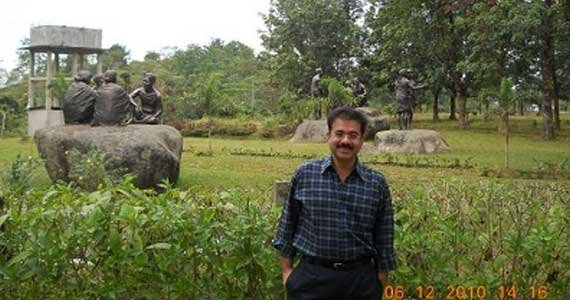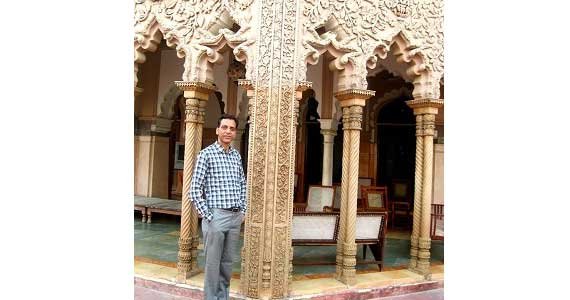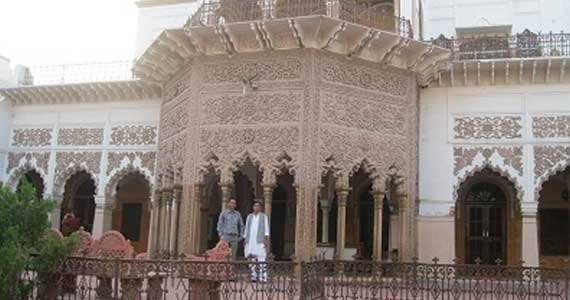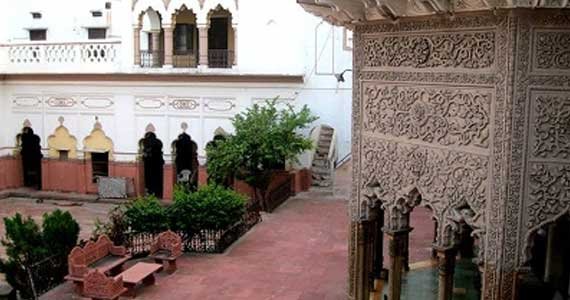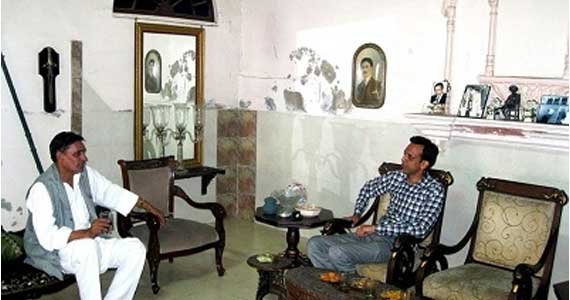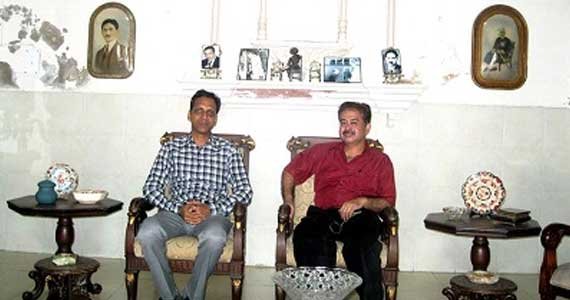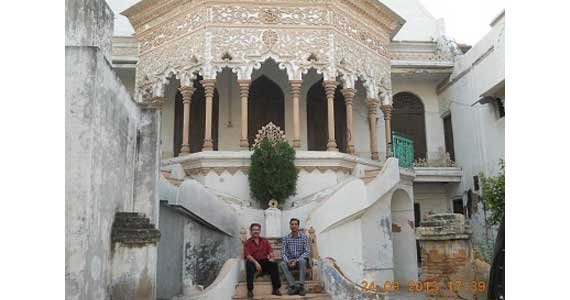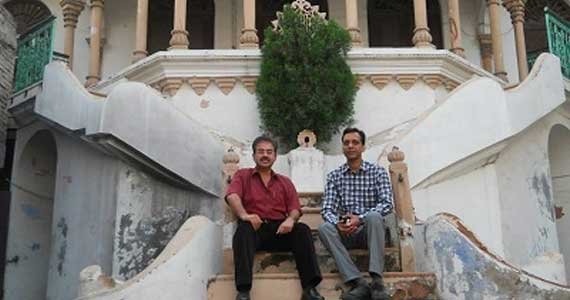Photograpy
Fort Cochin during monsoon - unbelievable sights and sounds
Fort Cochin is the old part of Cochin, established by Europeans who came in as traders. It has the oldest standing Church of India and magnificent old buildings which have been beautifuly and tastefully preserved, keeping the heritage character of this region in consideration. Fort Cochin during monsoons was one of the most beautiful places I have visited in India. The Jewish settlement is also closeby.
Gulmarg snowed out. Nature at its most beautiful
Fort Cochin is the old part of Cochin, established by Europeans who came in as traders. It has the oldest standing Church of India and magnificent old buildings which have been beautifuly and tastefully preserved, keeping the heritage character of this region in consideration. Fort Cochin during monsoons was one of the most beautiful places I have visited in India. The Jewish settlement is also closeby.
The Beautiful Kumbalgarh Fort
The construction of the Kumbalgarh Fort was started by the great ruler of Mewar, Rana Kumbha, in 1443. It is one of the largest fortifications in the world, its outer perimeter walls extending for 36 kilometers. The great warrior Rana Pratap was born in Kumbalgarh. The fort has the distinction of not having been won by any adversary. At present it is the most beautifully lit monument in India with one of the best light and sound shows in the country.
Rishikesh and Rajaji National Park, Feb' 2012
Our short trip of Rishikesh and Rajaji National Park. It was a wonderful trip which rejuvinated us all. We were very lucky to be able to spot a leopard while on a safari through the park, though it was at quite a distance from us and we could not take photographs. But the overall experience of being with green trees, a blue sacred river Ganges and mountains covered with forests was what was needed after spending months in the grind of a concrete cit
The Ranakpur Temple Complex, Dist. Pali, Region Marwar, Rajasthan
The Ranakpur Temple Complex, District Pali, Region Marwar, Rajputana (Rajasthan)
The main Jain Shrine at Ranakpur. No wonder, Arab travellers to India just before and around 1000 AD, while looking at the beautiful temples dotting the whole landscape of the Subcontinent (from Kabul to Madurai), commented that `these do not appear appear to have been made by the hand of man, but by jinns comming from the sky’. Sadly most of them are lost forever due to the ravages of time and man but Rajasthan was relatively more lucky.
Udaipur Palace Museum
The City Palace Museum at Udaipur is one of the most fascinating places I have visited. It has two segments, the museum and the crystal gallery. The later is open to only a few visitors but is a must-see for anyone who visits Udaipur. The most wonderful part was the quality of upkeep of the whole complex and the extremely friendly guides as well as visitor’s aids provided at the museums.
Avantiswami Temple
Ruins of Avantiswami temple, Avantipur, Dist. Pulwama, Kashmir
A number of temples were built by king Avantivarman (AD 855- 883), the larger of these is a Vaishnava temple on the banks of river Jhelum (called Vitasta in the Rig Veda). It was destroyed subsequently and buried for hundreds of years till the British finally excavated it in the 1800s. Ruins of another temple dedicated to Shiva stand a short distance away.
Beautiful Coorg or Kodagu
Kodagu or Coorg is a district that nestles the Western Ghats in south western Karnataka. The people residing here have a unique culture different from all other people of the country, the Kodavas and Kodagu Arebhashe gowdas being the primary residents. Both men and women wear a unique traditional dress and they have certain religious practices which are also unique. Kodava is their primary language. The people of this district have a strong martial tradition and are one of those rare communities in India who can carry a light firearm (gun) without licence within their district. Coorg has given India two of its finest military officers one of India only two Field Marshals Field Marshal Kodandera `Kippera Madappa Cariappa (the other being Field Marshal Sam Manekshaw) and General Kodendera Subayya Thimayya who served as Chief of Army Staff from 1957 to 1961 in the crucial years leading up to the conflict with China in 1962. Gen. Thimayya was the only Indian to command an Infantry brigade in battle during World War II and is regarded as the most distinguished combat officer the Indian Army has produced. Our alma mater, St. Marys Academy, is situated on Cariappa Street in Meerut cantonment named after the renowned officer of the Indian Army.
Assam - Travelling along Highway 37
I had travelled this road earlier also, but now going along it after 20 years was a new experience, some things remained the same, but some had changed forever – maybe just like me 🙂 I had travelled on this road innumerable times, but as soon as I stood at this road marker, something stirred inside me on reading those names again¦..old memories rushed through my mind both these places are so close to my heart and will always remain so
Khursid Manzil...haveli of Baghpat Nawab Koukab Hamid ji
Khursheed Manzil, ancestral haveli of Nawab Kaukab Hamid of Baghpat. It is a beautiful example of Indo-Islamic architecture with some exotic work on stone. Nawab sahib is an aluminous of our school, St. Marys Academy and was the Minister of Tourism of Utter Pradesh during which tenure he launched the Mahabharata Project in Western UP…
Cochin Harbour
Cochin was a traditional gateway to India with traders coming from Europe and Middle East to participate in a huge trade of spices and other products. It was this gateway which opened its hearts to Jews more than 2000 years ago and also to the first Christians the world had ever known. It is still an important trading post of India.
Remembering my recent visit to heaven, Conoor, Tamil Nadu
Cochin was a traditional gateway to India with traders coming from Europe and Middle East to participate in a huge trade of spices and other products. It was this gateway which opened its hearts to Jews more than 2000 years ago and also to the first Christians the world had ever known. It is still an important trading post of India.
Travelling through Marwar
India Sea Shell Museum at Mahabalipuram, Tamil Nadu. A must see for everyone actually. It has on display an amazing private collection of nearly 40000 sea shells of nearly all types and species, a collection of a single gentleman Mr. Raja Mohammad. It is both informative as well as a treat for the eye

Traveling through Western Uttar Pradesh, Dist. Buraut
Every part of Meerut region is full of unexplored history. On 21-11-2011, a Sunday, we re-visited a series of villages in Buraut. Many of these villages had been identified by us a freedom struggle villages during the past 3 years and designated as `Kranti Gram’ villages. But a lot more needs to be done in the future regarding the history of Baghpat district.
An important ancient village of this region is Baragaon which is linked to a character of the epic Ramayan – Ravan. The myth here is linked to the ancient epic Ramayana and a relatively recent temple stands at the site of a much more ancient temple. Broken remnants from that ancient temple are also worshiped here, as can be seen in this photo – a beautiful image of devotion and belief. An ancient vishnu idol is being worshiped here in the temple at village Ravan. It is one of the few surviving speciments of statues of Vishnu in Western UP, most have been lost due to the turbulance of the past 1000 years. This statue must have been worshiped in the original temple which stood at this site but was broken hundreds of years ago.

The sights and colours of Udaipur
India Sea Shell Museum at Mahabalipuram, Tamil Nadu. A must see for everyone actually. It has on display an amazing private collection of nearly 40000 sea shells of nearly all types and species, a collection of a single gentleman Mr. Raja Mohammad. It is both informative as well as a treat for the eyes.
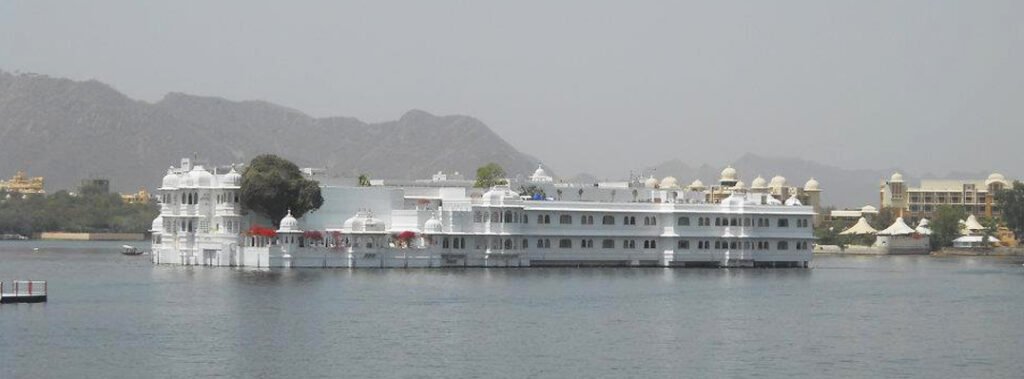
India Sea Shell Museum at Mahabalipuram, Tamil Nadu
A must see for everyone actually. It has on display an amazing private collection of nearly 40000 sea shells of nearly all types and species, a collection of a single gentleman Mr. Raja Mohammad. It is both informative as well as a treat for the eyes.

VICTORIA MEMORIAL, KALKOTA
The official icon of Calcutta or Kolkata is the Victoria Memorial, a building built in memory of Queen Victoria. The foundation stone was laid by the Prince of Wales, later King George V on the 4th of January1906. The design of the building was made by Sir. William Emerson, President of the British Institute of Architecture. It was completed in 1921.
The designers had the Taj Mahal in their sight and probably wanted this building to be an icon of the British Raj like the Taj is an icon of Mughal rule. The extravagance of such endeavours among millions of people living in poverty will always be debated, but aesthetics, art and design live in the minds of men possessed, disconnected from the realities of what surrounds them!
Like the Taj, the building has a large central dome with minarets on four sides, built in white Makrana marble and having lawns and gardens surrounding it. It houses an interesting museum within it.

THE YELLOW AMBASSADOR TAXI
Upto the 1950s Calcutta was one of the primary centers of economic activity in India, countering both Bombay and Madras as they were called then. From late 1950s began a process of slow killing of the city of Calcutta which was undertaken by the Indian Communists. Contrary to their counterparts in other parts of the world, this Indian subspecies had the capacity to debate, discuss and mouth words phrases and notions of this grand ideology but their actions on the ground were extremely detrimental to the very people they vouched to protect. Militant trade unionism and hair brained policies of successive communist governments killed the very spirit of Calcutta and Kolkata, as it is presently called, is a ghost of its past.
With the iconic yellow Ambassador taxi of Calcutta or Kolkata. Every city has a symbol, for me the yellow taxi is the real symbol of Calcutta, shining out in its brightness among the humdrum of its busy streets lined by tall colonial era buildings long past their age …. I spent few days there, some of the best of my life, thanks to my friends Prithvi Rathore and Harpreet Singh. Meeting Mr. Sauvik Majumdar was the icing on the cake.

Mahabalipuram
Mahabalipuram – the Shore Temple. Built between 700 and 728 AD by Pallav king Narsimhaverman I it is today a world heritage site. It consists of three shrines, two to Shiva and a central shrine having a reclining Vishnu made out a single rock. The sun rays enter the east and west facing shrines at sunrise and sunset. It is accepted that in ancient times there was a group of 7 such temples at this site which acted as landmarks for ships sailing in from East Asia as well as Europe for trade at ports all along this part of the coast.

Mehrauli Monument 1 Adam Khan
Photos again of 22nd May visit. Adham Khan was a general in the army of Akbar and was also the son of his wet nurse, Maham Anga. In 1561 he fell out with another noble of Akbar named Ataga Khan who was also the son of another of his wet nurse. Adham Khan killed Ataga Khan and for this act Akbar punished him with death by having him thrown down the walls of Agra Fort. Maham Aga also shortly died of grief after the 40 day mourning period and Akber had this monument built for them where they were buried.
Unlike traditional Mughal design, the monument has an octagonal shape. In about 1830 a British officer converted the monument into his residence but removing the structure of the two graves. Subsequently the building functioned as a guest house, a police station as well as a post office. The tomb was finally restored on the orders of Lord Curzon, but only one was built, that of Maham Anga was not rebuilt within the monument.

Mehrauli Monument 2 Jahaz Mahal
The Jahaz Mahal is located within the heart of Mehrauli on the banks of an old lake called Hauz-e-Shamsi. It appears that probably in old times the water of the lake partly or completely surrounded the building, but at present it lies a few meters to the west of the main structure.
The monument appears to have been constructed in the pre-Mughal Sultanate period, during the Lodi era, (between 1452 – 1526). It appears to have functioned as a Sarai or inn, but could have been a pleasure resort for the nobility also. At present the cultural events of the famous annual event of Delhi, `Fulvalon ki sair’, take place in this monument.
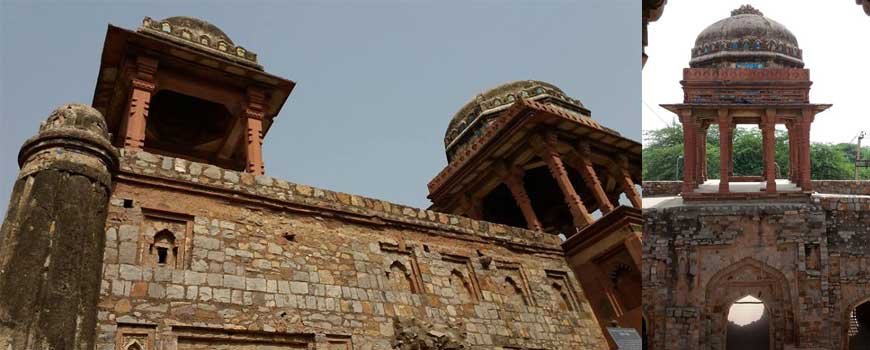
Merauli Monument 3 Gandak ki Baoli
In the above photograph taken on 22nd of May (last month) the Gandhak ki baoli was nearly filled with water, reaching the top floor, but it is a 5 story step well with pillared corridors all around. The water in this step-well contains sulphur and smells of it, giving it its name. It was said to have medicinal properties. The Baoli lies in the heart of Mehrauli market.

Mehrauli Monument 4 - Unique Mosque
Visit same date – 22nd May. This is a large mosque with a sprawling courtyard within the ruins of the 1st city of Delhi which lie in the part of the ridge that extends behind the Qutub Minar. A guard was posted here and it is under the protection of the ASI but there was absence of any information board. It appears to be of the Sultanate period.

Mehrauli Monument 5 - Quli Khan
Visited and photographed on 22nd May. Mohd. Quli Khan was a brother of Adam Khan, foster brother of Akbar. His tomb, built in the 17th century, lies close to the Qutub Minar, affording a beautiful view of the monument, within the ruins of the first city of Delhi.
It was bought by Sir Thomas Theophilus Metcalfe (1795–1853), the Governor General last British Resident of Delhi. He converted into a `retreat’ called Dilkhusha (delight of the heart) by adding a structure all around it and surrounding it with extensive gardens and `follies’.
There are two meaning of the word `Follies’ one of these being – a costly ornamental building with no practical purpose, especially a tower or mock-Gothic ruin built in a large garden or park.
Metcalf used the building as a residence away from the main city of Delhi which lay at quite a distance. It was a special retreat during the monsoon months, providing an excellent view of the Qutub minar and surrounded by lakes and well kept gardens. Metcalf also rented it out to visitors and it is mentioned specially to honeymoon couples.

Pondicheery
At Pondicheery … Auroville and the sea
At the Ashram (hermitage) of Sri Aurobindo in Pondicherry. Sri Aurobindo was a freedom fighter imprisoned by the colonialists and subsequently after being released became a sage. Sri Aurobindo and Swami Vivekanand were the fountain-heads of the spiritual bases of the Indian Freedom Struggle as well as of the modern Indian nation. Wanted to visit this Ashram all my life … got this opportunity today!
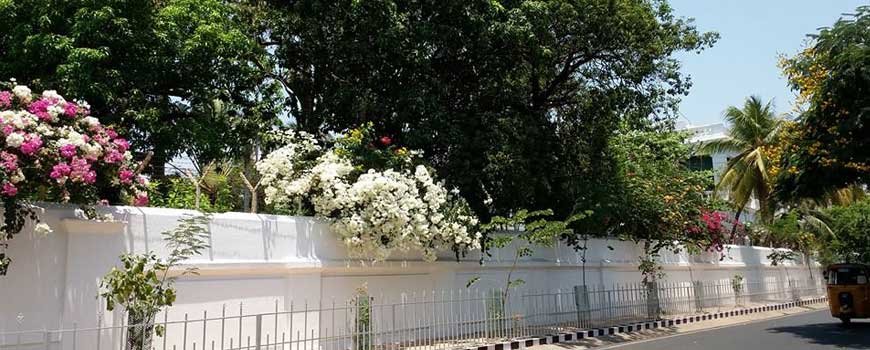
ORCHA
It was awsome, it was as if we have been transported into a lost city by magic while reading a fairytale… Orcha was built by the Bundela Rajputs who gave their name to the Bundelkhand region. This region, which today lies divided between UP and MP, has a unique language, culture and is extremely rich in visual arts. Sadly, due to many reasons, it also is one of the poorest in the country during our times. Orcha was the second capital of the Bundelas and their velor during medieval battles is the stuff legends are made of.

JHANSI
The saga of the Jhansi fort and its residents are itched in the collective identity of India.
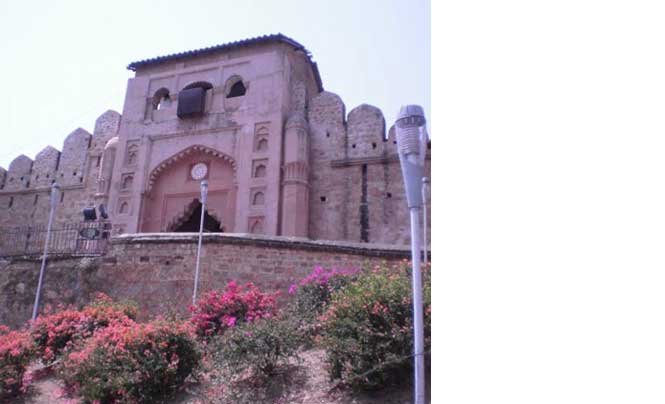
The Old European Cemetery at Kanpur
One of the biggest surprises for me was a visit of this cemetery within the heart of Kanpur city (Civil Lines) which has graves dating to a time before Delhi and Meerut were even taken by the East India Company, many dating to the late 1700s.
The excellent maintenance of the graves and the surrounding area – a beautiful boundary wall, no encroachers and an excellent `walking pathway’ under construction were a treat for the eyes. The reason was unbelievably scientific preservation and maintenance of this cemetery by the Lucknow circle of the Archaeological Survey of India. I had a long conversation with the officer in charge of Kanpur region, Mr. Manoj Kumar Verma, and congratulated him for his excellent endeavour (he is primarily responsible for this work).
The ASI used a book written by a European lady of Kanpur who died in 1985 to mark out each and every grave they could. Then they put up metal plates in front of these graves to mark them. A scientific method was used to reconstruct the graves using a mixture which was originally used for their construction. The stone markers were cleaned and preserved beautifully, including some in black stone.





















































































































